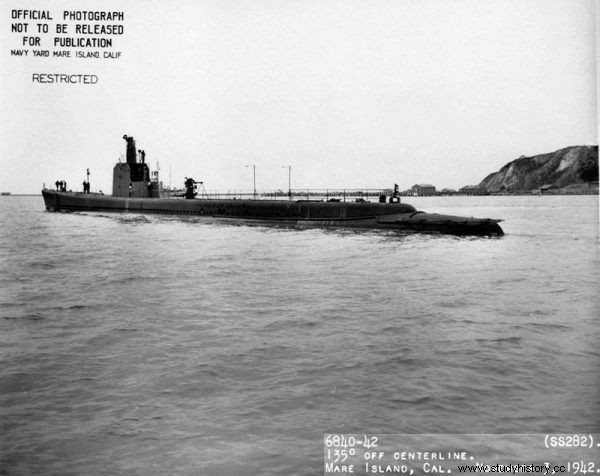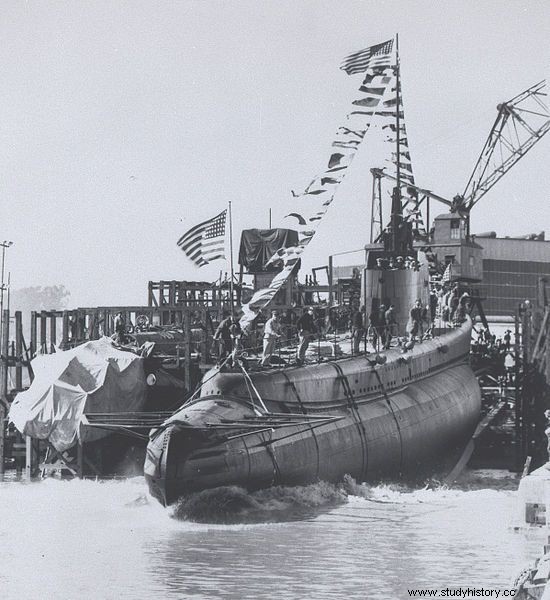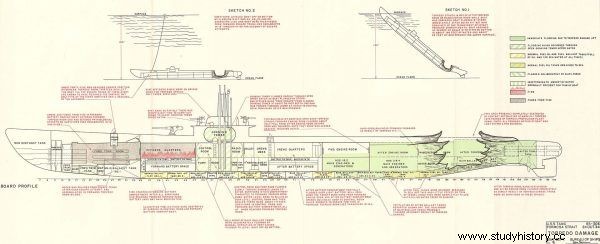USS Tang and USS Tulibee sank with their own torpedoes, USS Harder shot Japanese snipers down from trees, USS Bofin torpedoed a bus and a harbor crane, and USS Tresher was caught with a fishing rod. The American submarines that launched the fight against the Japanese fleet had an ice cream machine, a turntable and a Coca-Cola concentrate on board.
The course of World War II in the Pacific is not as well known in Poland as the struggle closer to us - in Europe and North Africa. However, it is worth knowing that the fights in the DTDW (Far Eastern theater of military operations) were as fierce and bloody as those in our region. Americans with great difficulty, almost one meter by meter, deprived the Japanese of lonely coral atolls, smaller and larger islands, and then also huge archipelagos, such as the Philippines. "Yanks" fought with "Japs" in tropical jungle, on sandy beaches, volcanic tuffs, in caves and in the mountains and also in big cities, such as the capital of the Philippines - Manila.
However, the key to achieving a victory over Japan on land was to gain absolute superiority on the seas. After the "Day of Disgrace", the Japanese attack on Pearl Harbor, the Americans wanted revenge. They quickly recovered from the blows and went on the offensive. Admiral Harold Stark ordered "unlimited air and submarine warfare against Japan to begin."

Admiral Harold Stark 1943
The US Navy submarines were the first to enter combat. From the land, they were supported by radio intelligence and teams of cryptologists reading Japanese ciphers, who were doing better and better. It was thanks to the cryptologists that the ships going to sea went "for sure" to the designated positions. Usually in the indicated places there were Japanese ships and ships to which torpedoes could be fired or - in the case of smaller units - attacked with an on-board gun.
Botched torpedoes - no success
Unfortunately, in the initial phase of the war, American submarines had huge problems with sinking Japanese ships and ships. Many "greasy morsels" sailed calmly, not even noticing that ... they were torpedoed! American Mark XIV torpedoes bounced off the sides of the attacked ships, did not explode or exploded too early , they sank, swam under the target, deviated from their course, turned around and did other such pranks.
The Pacific Fleet Command was long reluctant to accept the fact that modern torpedoes were simply fluffed. Before the war, no faults were found, because the torpedo tests were carried out in the "economy" version, without warheads. During sea trials and maneuvers, the torpedoes were unarmed, so they did not explode. This is because the "wise" staff members believed it was a pity to destroy them. One cost around $ 10,000 ...
Unfortunately, this approach later took revenge, because after America entered the war, the armed torpedoes did not explode either. It caused rage on the decks of the submarines. The captains, after returning to the port, wrote in their reports that well-aimed torpedoes were swimming exactly in the center of the enemy ship, hitting it and ... not exploding. They often passed under the hull of the ship under attack, although they were "programmed" to a good depth. Only after six months of the war with Japan (in June 1942), after receiving many critical reports, it was decided to conduct combat tests, which confirmed that the torpedoes had many very serious defects. It turned out that the immersion control system malfunctions, the magnetic detonator is malfunctioning, and the contact detonator has a too weak pin and does not initiate an explosion after hitting the target.
Before all faults were repaired, American submarines had launched six, eight, ten, or even more torpedoes at a targeted lock and… nothing. The USS Wahoo, the most famous American submarine, fired seven torpedoes on two ships on its first patrol. None exploded!

USS Tunny (SS-282)
Even more unlucky was the USS Tunny, whose torpedo tubes were "paraded" on April 9, 1943 by three extremely valuable and dangerous Japanese carriers:Hiyo, Junyo and Taiyo. Tunny fired 10 torpedoes from a distance of just 700 meters, but only one hit the target and exploded, causing minor damage to the Taiyo escort carrier. The remaining torpedoes exploded prematurely.
One can imagine the disappointment of the crew of the USS Tinos, who "escaped from under the barrel" of the Tonan Maru, a huge Japanese transport ship. On July 24, 1943, Captain Randall "Dan" Daspit launched as many as 15 torpedoes to this ship! No effect. The untouched transport went blue. The furious captain wrote in the report that all shots were correct and on target, but the torpedoes did not explode. These torpedoes were just plain bad, like the tracks at the scene of a train accident…
Shooting with a "clogged barrel"
Even with the malfunctioning fuse fixed, torpedo maintenance continued to cause problems for American submarines. Unusual and often tragic situations related to the handling of "cigars" happened almost until the end of the war. For example, on the aforementioned USS Wahoo, while blowing out the torpedo tubes, the sailor-torpedo operator accidentally (!) Pulled the "pal" handle and started the torpedo. The problem was that the launch cover was still closed… The torpedo damaged the hatch, but did not take off, and the ship continued patrol with a damaged launcher and a jammed torpedo in the hatch. The crew felt as if they had a delay bomb on board. Fortunately, this time Wahoo is fully back in port.

The launch of the "Wahoo" on February 14, 1942 at the Mare Island Naval Shipyard.
A similar situation occurred on the USS Thresher in December 1942. The torpedo engine was accidentally started in a closed tube. When trying to remove it, it got stuck. The sailors pulled it out after many hours of arduous work that could only be done on the surface of the sea and threw it into the water. However, Launcher No. 1 was unusable until the end of the voyage. Such situations happened many times in the initial phase of the war. Apparently some ship imp was still pulling on the pal lever.
Tragic self-sinking
During World War II, there were 30 cases of the ship being hit by its own torpedo. Two such events ended tragically and happened in the Pacific. The first ship lost in this way was the USS Tulibee, which sank on March 26, 1944. While operating near the Palau Islands, attacked a Japanese convoy and fired two torpedoes at it. Two minutes later one of them came back and hit the home unit. Only one crew member, who was on board at the time of the explosion, survived the fast sinking ship. He fell into the water and was taken prisoner by the Japanese, until the end of the war.
Another such event happened on October 25, 1944, when the USS Tang, operating near Formosa (today's Taiwan), hit a Japanese transport ship with several torpedoes. Tango's captain Richard O'Kane wanted to finish the damaged ship and launched his last torpedo. Unfortunately, the fate was cruel. The underwater missile emerged right in front of the target, veered sharply, circled and hit Tango's torpedo compartment . Only nine sailors who were captured by the Japanese escaped from the ship, sunk at a depth of 55 meters.

Simplified visualization of the destruction of the rear torpedo compartment of the USS "Tang" (SS-306), caused by the explosion of the Mk 18 torpedo. The fire of the ship's batteries under the officers' compartment resulted in the death of most of the survivors of the torpedo explosion gathered in the forward torpedo compartment. The upper visualizations show - from the right:the position of the ship shortly after being hit by its own torpedo, on the left - the position of the ship during an attempt to evacuate the crew. An open front hatch visible above the forward torpedo compartment.
Such a fate was miraculously avoided by the USS Perch, which fired four torpedoes into a heavily loaded merchant ship. Neither of them hit their target, but one, for unknown reasons, came full circle and exploded near the side of its "owner". Perch's deck was covered with small and large pieces of metal. Fortunately, they did not cause much damage and the ship was allowed to continue patrol.
The USS Greenling fired two torpedoes at the precious freighter Hakonesan Maru. One hit and set off a big fire, but the other went off course, turned around and "targeted" Greenling. Fortunately, it exploded several dozen meters before hitting its hull.
The crew of the USS Dorado was very unlucky, but it was sunk on October 12, 1943 in "calm waters" near the Panama Canal. It seems that the American ship was mistakenly bombed by the American PBM Mariner patrol plane that took off from the infamous military base in Guantanamo, Cuba.
The reasons for the sinking of the very effective USS Seawolf, which had 27 sunken Japanese units (which means that she was one of the most effective American ships), are unclear. Seawolf was missing on October 3, 1944 near the Moluccan Archipelago. It is assumed that the American destroyer USS Richard M. Rowell, which operated in the area, sunk it. 83 seamen were killed on the ship, as well as 17 passengers on a special mission.
Unusual actions and remarkable successes
An unusual duel during an unusual mission happened to the USS Harder. It was sent on a mission to search for downed airmen who landed on small islands scattered across the Pacific Ocean in the Carolingian archipelago. On August 31, 1943, the captain received orders to approach Tangaulap Island and find John R. Galvin, the downed F6F Hellcat pilot. Four sailors volunteered and boarded the pontoon to transport the injured airman from the beach to the ship.
While the Harder sailors were towing a small life raft with Galvin with great difficulty, the ship's crew conducted a shooting duel with Japanese snipers over their heads. They sat down on the coastal trees and from there began shelling the ship and the people carrying out the rescue operation. The Japanese shooters from the trees were knocked down not only by Harder, but also by the American fighters called for help. The rescued pilot spent another 30 days on the submarine before Harder completed his patrol and returned to port.

'Hit' em harder '' pennant.
Let us recall some more interesting underwater facts from the Pacific War period:
• USS Harder was famous for its incredible efficiency, as it sank four Japanese destroyers within four days during its fifth patrol in the Celebes Sea. This voyage was called the "greatest patrol of the war" due to the value of the sunken ships (destroyers). However, it is worth remembering about the extremely effective U-107 u-boat and its record patrol. LINK
• On July 9, 1942, near Kwajalein Atoll, Japanese ships caught a submerged American ship "with a fishing rod". The USS Thresher had previously sunk the tender Shinisho Maru. The Japanese wanted to get back and hunted the enemy with ropes with magnetic hooks dropped from the ships, which were to attach to the protruding parts of the submarine. One of the discarded "fishing rods" did catch the Tresher. The ship could not go any deeper, the Japanese were slowly towing it to the surface with a strong winch. Their goal was probably to take over an intact, serviceable ship with the entire crew. Tresher miraculously managed to free himself from the "hook" by performing acrobatic "up-down" and "right-left" maneuvers underwater.
• The captain of the aforementioned Tresher showed quite a bit of ingenuity by ordering the attachment of a ship's gun to the barrel of ordinary naval binoculars. During the patrol, the ship did not have sights for its water "sting".
• "Historical curiosities" could not ignore the information that Coca-Cola was always available on American submarines. 200 liters of this iconic drink concentrate were taken on the cruise which was mixed with fresh water and gassed with carbon dioxide, which was abundant in the submarine.
• Modern "Gato" ships, such as the above-mentioned USS Harder, also had an ice cream machine, a turntable and a movie projector on board.
• USS Boffin performed an incredible feat during its sixth patrol near the Ryukyu Islands in Okinawa. On August 10, 1944, Boffiin tracked down a convoy of Japanese ships bound for the small port of Minami Daito. He swam in after them and attacked as the ships docked. One of his torpedoes exploded on the beach, the other destroyed a merchant ship, and the third - as planned by the captain - destroyed the pier, the bus and the harbor crane on it. The pier, bus and crane were painted on the USS Bofin combat flag as valuable war achievements.

USS Archer-Fish
• USS Albacore recorded a real "golden shot" torpedo on June 19, 1944. Hitting only once, he destroyed the aircraft carrier Taiho, extremely valuable to the Japanese. Albacore fired three torpedoes at the colossus and hid under the water. After being hit by only one torpedo, Taiho continued on only at reduced speed. It turned out, however, that the torpedo explosion violated the aviation gasoline tanks, the vapors of which filled first the deck elevator shaft, and then the entire hull of the aircraft carrier. There was a spark that set off the explosion, and six hours after it hit, the big ship went to the bottom.
• A similar well-aimed shot was recorded by the USS Archer-Fish, which on November 28, 1944 fired six torpedoes to a "large tanker" spotted in the darkness of the night. Four torpedoes hit the target, which turned out to be the largest Japanese carrier Shinano, on its maiden voyage. After a few hours, the ship capsized and sank. The aircraft carrier Shinano was one of the three largest ships of World War II, along with the super battleships Yamato and Mushasi.
• During World War II, the US Navy had 288 submarines. 250 were used against Japan. 52 were lost. Four were sunk in accidents, 48 in combat. 3,500 submarine sailors died in the Pacific.
